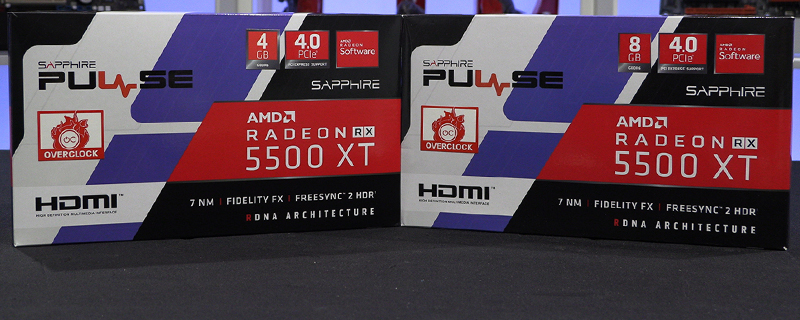Sapphire RX 5500 XT Pulse 4GB vs 8GB Review
Conclusion
Naturally, when you’re at this end of the market, the balance between price and performance is the critical consideration. A handful of frames per second can be all you need to go from endless settings tweaking to just getting on with buttery smooth playing in every scenario.
There is only £20 between the 4GB version of the Sapphire Pulse RX 5500 XT and the 8GB model, with the prices at £159.99 and £179.99 respectively. This places the RX 5500 XT against the GTX 1650 for the 4GB model and the GTX 1660 for the 8GB model. There is some muddying of the waters in the Nvidia range as there are the Ti and Super models to consider. Whilst we have tested the 1660Ti it’s considerably more expensive so falls outside of the remit of this comparison. We weren’t sent a GTX 1650 Super to test so while it fits between the two different RX 5500 XT prices we can’t tell you how they match up in performance terms. It’s not because we are ignoring it, but we can only test what we’re sent.
In performance terms, the RX 5500 XT 4GB bests the GTX 1650 well enough in most tests that we think it would be the one to plump for if you’re very limited in funding. The 8GB model and GTX 1660 comparison are much more title-specific, and so it’s worth bearing in mind a particular title if you’re committed to a certain game rather than looking at a card capable in the majority of titles. Another consideration when thinking about price and performance is the quality of the cooler you’re getting. With the two Sapphire Pulse cards the cooler is excellent in both noise and cooling terms. With dual fans and a heatsink tied with fat heatpipes coupled to a heat-spreading backplate and wide exhaust the cards remain cool and can utilise the boost function to reach new heights. So whilst you’re getting a good Navi card for this money you’re usually looking at the simpler of the Nvidia options for the same price. How much noise and temperatures affect you is all a matter of personal taste, and we know just as many people who will give up their hearing for higher framerates as we do those who want silence even if it comes at the cost of a few frames per second.
Although the Navi RX 5500 XT is specifically designed to run at the ultra-popular 1080p resolution, you can see in our testing that the extra memory of the 8GB version generally brings a handful of extra frames in most titles, and if you’re planning to run a less taxing game at 1440p, then it would be the one to plump for as the extra memory really makes itself known at that resolution. We did run 4K tests for completeness sake, but naturally, this is not a card designed for that particular resolution, even if you’re playing a very undemanding game. With the Radeon Anti-Lag improving responsiveness in competitive titles the RX 5500 XT has much to offer the hardcore gamer, and the affordability of FreeSync displays lets you have every frame available to react without enduring the screen tearing you get when VSync is off.
With both the 8GB and 4GB Sapphire Pulse RX 5500 XT cards coming in underneath £180 you can be assured of good gaming performance at maximum settings in nearly every title, with only the most demanding visual feasts requiring some careful settings choices. For the gamer on a budget they are a very wise choice indeed and win our OC3D Gamers Choice Award.
Discuss the Sapphire Pulse RX 5500 XT in our OC3D Forums.




